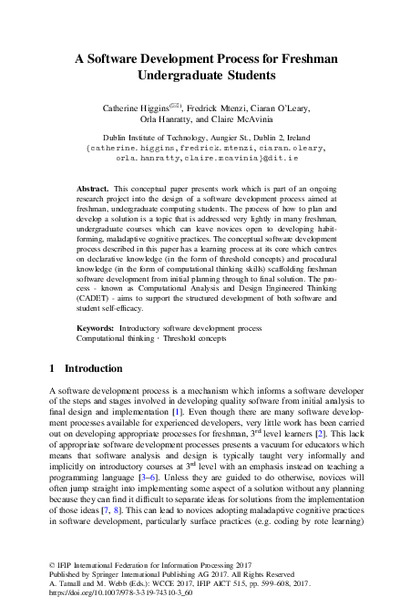A Software Development Process for Freshman Undergraduate Students Case Study for Grade 6 Students Group
Catherine Higgins, Fredrick Mtenzi, Ciaran O’Leary, Orla Hanratty, Claire McAvinia
Zu finden in: Tomorrow's Learning: Involving Everyone. Learning with and about Technologies and Computing (Seite 599 bis 608), 2017
  |
 |
 Diese Seite wurde seit 3 Jahren inhaltlich nicht mehr aktualisiert.
Unter Umständen ist sie nicht mehr aktuell.
Diese Seite wurde seit 3 Jahren inhaltlich nicht mehr aktualisiert.
Unter Umständen ist sie nicht mehr aktuell.
 Zusammenfassungen
Zusammenfassungen
 This conceptual paper presents work which is part of an ongoing research project into the design of a software development process aimed at freshman, undergraduate computing students. The process of how to plan and develop a solution is a topic that is addressed very lightly in many freshman, undergraduate courses which can leave novices open to developing habit-forming, maladaptive cognitive practices. The conceptual software development process described in this paper has a learning process at its core which centres on declarative knowledge (in the form of threshold concepts) and procedural knowledge (in the form of computational thinking skills) scaffolding freshman software development from initial planning through to final solution. The process - known as Computational Analysis and Design Engineered Thinking (CADET) - aims to support the structured development of both software and student self-efficacy.
This conceptual paper presents work which is part of an ongoing research project into the design of a software development process aimed at freshman, undergraduate computing students. The process of how to plan and develop a solution is a topic that is addressed very lightly in many freshman, undergraduate courses which can leave novices open to developing habit-forming, maladaptive cognitive practices. The conceptual software development process described in this paper has a learning process at its core which centres on declarative knowledge (in the form of threshold concepts) and procedural knowledge (in the form of computational thinking skills) scaffolding freshman software development from initial planning through to final solution. The process - known as Computational Analysis and Design Engineered Thinking (CADET) - aims to support the structured development of both software and student self-efficacy. Dieses Kapitel erwähnt ...
Dieses Kapitel erwähnt ...
 Personen KB IB clear | Harold Abelson , Karen Brennan , Andrea diSessa , Evelyn Eastmond , Philip J. Guo , Yasmin B. Kafai , Petra Kastl , Ulrich Kiesmüller , Chris W. Loftus , John Maloney , Abraham Maslow , Amon Millner , Andrés Monroy-Hernández , Mitchel Resnick , Anthony Robins , Ralf Romeike , Eric Rosenbaum , Janet Rountree , Nathan Rountree , Natalie Rusk , Jay Silver , Brian Silverman , Lynda Thomas , Lew Semjonowitsch Vygotsky , Niklaus Wirth , Carol Zander | |||||||||||||||||||||||||||||||||||||||||||||||||||||||||||||||||||||||||||||||||
 Begriffe KB IB clear | computational thinkingcomputational thinking , notional machine , Selbstwirksamkeitself efficacy | |||||||||||||||||||||||||||||||||||||||||||||||||||||||||||||||||||||||||||||||||
 Bücher |
| |||||||||||||||||||||||||||||||||||||||||||||||||||||||||||||||||||||||||||||||||
 Texte |
|
 Zitationsgraph
Zitationsgraph
 Zitationsgraph (Beta-Test mit vis.js)
Zitationsgraph (Beta-Test mit vis.js)
 Zeitleiste
Zeitleiste
 Anderswo finden
Anderswo finden
 Volltext dieses Dokuments
Volltext dieses Dokuments
 |  A Software Development Process for Freshman Undergraduate Students: Artikel als Volltext bei Springerlink ( A Software Development Process for Freshman Undergraduate Students: Artikel als Volltext bei Springerlink ( : :  , 363 kByte; , 363 kByte;  : :  ) ) |
 Anderswo suchen
Anderswo suchen 
 Beat und dieses Kapitel
Beat und dieses Kapitel
Beat hat Dieses Kapitel während seiner Zeit am Institut für Medien und Schule (IMS) ins Biblionetz aufgenommen. Beat besitzt kein physisches, aber ein digitales Exemplar. Eine digitale Version ist auf dem Internet verfügbar (s.o.). Es gibt bisher nur wenige Objekte im Biblionetz, die dieses Werk zitieren.












 (
(





 Biblionetz-History
Biblionetz-History